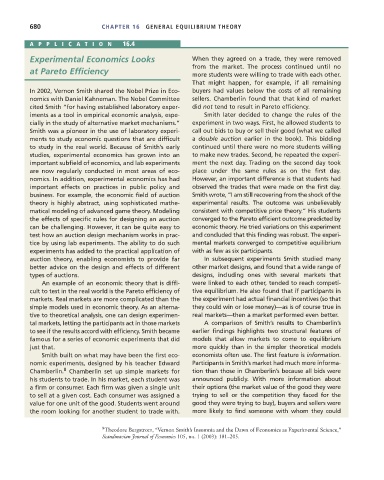Page 706 - Microeconomics, Fourth Edition
P. 706
c16GeneralEquilibriumTheory.qxd 8/16/10 9:14 PM Page 680
680 CHAPTER 16 GENERAL EQUILIBRIUM THEORY
APPLICA TION 16.4
Experimental Economics Looks When they agreed on a trade, they were removed
from the market. The process continued until no
at Pareto Efficiency
more students were willing to trade with each other.
That might happen, for example, if all remaining
In 2002, Vernon Smith shared the Nobel Prize in Eco- buyers had values below the costs of all remaining
nomics with Daniel Kahneman. The Nobel Committee sellers. Chamberlin found that that kind of market
cited Smith “for having established laboratory exper- did not tend to result in Pareto efficiency.
iments as a tool in empirical economic analysis, espe- Smith later decided to change the rules of the
cially in the study of alternative market mechanisms.” experiment in two ways. First, he allowed students to
Smith was a pioneer in the use of laboratory experi- call out bids to buy or sell their good (what we called
ments to study economic questions that are difficult a double auction earlier in the book). This bidding
to study in the real world. Because of Smith’s early continued until there were no more students willing
studies, experimental economics has grown into an to make new trades. Second, he repeated the experi-
important subfield of economics, and lab experiments ment the next day. Trading on the second day took
are now regularly conducted in most areas of eco- place under the same rules as on the first day.
nomics. In addition, experimental economics has had However, an important difference is that students had
important effects on practices in public policy and observed the trades that were made on the first day.
business. For example, the economic field of auction Smith wrote, “I am still recovering from the shock of the
theory is highly abstract, using sophisticated mathe- experimental results. The outcome was unbelievably
matical modeling of advanced game theory. Modeling consistent with competitive price theory.” His students
the effects of specific rules for designing an auction converged to the Pareto efficient outcome predicted by
can be challenging. However, it can be quite easy to economic theory. He tried variations on this experiment
test how an auction design mechanism works in prac- and concluded that this finding was robust. The experi-
tice by using lab experiments. The ability to do such mental markets converged to competitive equilibrium
experiments has added to the practical application of with as few as six participants.
auction theory, enabling economists to provide far In subsequent experiments Smith studied many
better advice on the design and effects of different other market designs, and found that a wide range of
types of auctions. designs, including ones with several markets that
An example of an economic theory that is diffi- were linked to each other, tended to reach competi-
cult to test in the real world is the Pareto efficiency of tive equilibrium. He also found that if participants in
markets. Real markets are more complicated than the the experiment had actual financial incentives (so that
simple models used in economic theory. As an alterna- they could win or lose money)—as is of course true in
tive to theoretical analysis, one can design experimen- real markets—then a market performed even better.
tal markets, letting the participants act in those markets A comparison of Smith’s results to Chamberlin’s
to see if the results accord with efficiency. Smith became earlier findings highlights two structural features of
famous for a series of economic experiments that did models that allow markets to come to equilibrium
just that. more quickly than in the simpler theoretical models
Smith built on what may have been the first eco- economists often use. The first feature is information.
nomic experiments, designed by his teacher Edward Participants in Smith’s market had much more informa-
8
Chamberlin. Chamberlin set up simple markets for tion than those in Chamberlin’s because all bids were
his students to trade. In his market, each student was announced publicly. With more information about
a firm or consumer. Each firm was given a single unit their options (the market value of the good they were
to sell at a given cost. Each consumer was assigned a trying to sell or the competition they faced for the
value for one unit of the good. Students went around good they were trying to buy), buyers and sellers were
the room looking for another student to trade with. more likely to find someone with whom they could
8 Theodore Bergstrom, “Vernon Smith’s Insomnia and the Dawn of Economics as Experimental Science,”
Scandinavian Journal of Economics 105, no. 1 (2003): 181–205.

